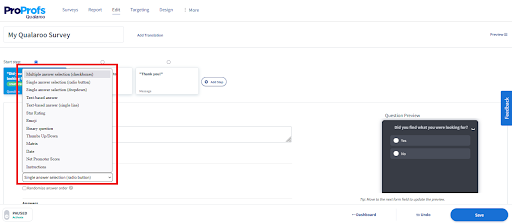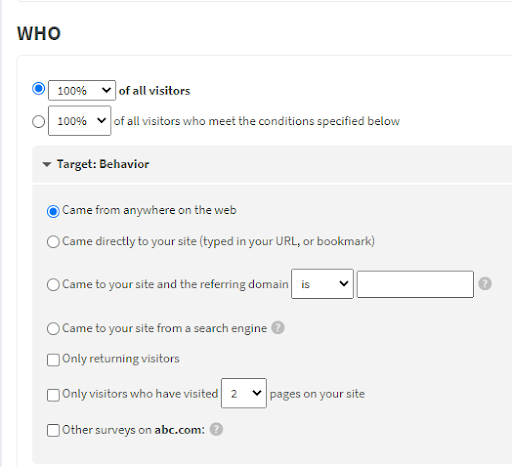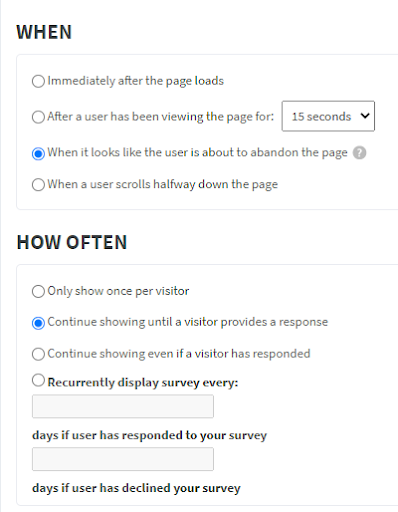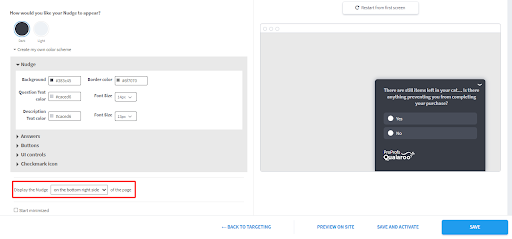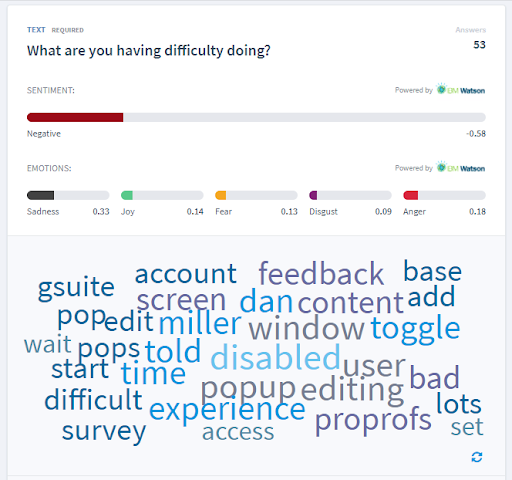Website surveys are designed to solicit specific responses from your visitors. They are shown to the visitors when they fulfill certain predefined conditions on your website.
Working with website surveys is a 4-step process. It includes finding the correct tool, designing the survey, deploying it, and analyzing the collected data.
1.) Choosing the Correct Tool
You can always code your way to implement your own website survey system, but using survey software will save both your time and effort. Deciding on the correct tool depends on several factors, such as your budget, features offered by the tool, its usability, learning curve, and data interpretation ability. Use a versatile tool that offers personalization options, design flexibility, targeting options, and in-depth data analysis.
2.) Designing the Survey
Once you have set up the tool, the next step is to create the survey. It includes the following steps:
- Deciding the right questions.
- Choosing the right answer selection types.
- Using desired targeting options to show the survey to the correct audience.
- Customizing the design and branding.
The questions you want to ask in your survey will depend upon the survey type and the information you intend to collect from the visitors. You can also use pre-built survey templates to get started with the questions and make changes as required.
There are different answer types to choose from for your questions, such as,
- Multiple-choice questions
- Single-choice
- Rating Scale
- Emoji ratings
- Likert Scale
- Dichotomous answer type (Yes/No)
- Matrix matching
- Free-text
If you want to read about each of these in detail, please refer to the guide >> Answer selection types
3.) Targeting the Right Audience
If you get the data you require, you need to ask the right people at the right time. The advanced targeting options help you embed the survey on the desired page and show it to the right audience segment. Here are the different ways you can target:
- Target visitors by traffic source: This allows you to direct the website survey towards visitors who only land up from a particular source, such as an ad campaign, search engine, or social media.
- Target visitors by visit length or depth: This allows the website survey to be delivered only to people who spend a certain amount of time or visit a specified number of pages on the site.
- Target by the number of visits: With the help of cookies, many website surveys can target visitors based on the number of visits they've made to the site.
- Target by activity: This targeting allows the website survey to target visitors who take specific actions, like attempting to navigate away from the website.
You also need to decide when you want to show the survey. For example:
- As soon as the page loads.
- After the visitor has been on the page for a certain time.
- When the visitor is about to leave.
Last but not least, customize your survey design to make it a part of your website.
- Edit the theme and appearance of the survey
- Choose its position on the page to make it non-intrusive
4.) Deploying the Survey
Most website surveys function similarly — they are displayed after a brief delay to the visitors who meet a set of criteria defined beforehand. The people setting up the survey can decide when it appears and in front of which type of visitor.
There are a number of ways to display the surveys on your website. These are:
- Widget Surveys
- Pop-up surveys
- Collapsible pop-ups
- Fixed pop-ups
Widget surveys are micro surveys attached at the corner of your webpage. They are non-obtrusive and non-interfering. They don't cover up the screen, and the visitors have the freedom to fill them up whenever they want while browsing the website.
Fixed pop-up surveys are shown to the visitors when specific conditions on the page or website are fulfilled. They are displayed as web page overlays to draw visitors' attention. The visitors need to fill them out or close them to continue interacting with the page.
A Collapsible pop-up survey is something in between a pop-up survey and widget survey. It is also laid on top of the page. But unlike a popup survey, the visitors can minimize it to continue browsing the website and open it again when they are ready to fill it.
5.) Analyzing the Data
Survey Data analysis involves digging through the survey responses and finding out meaningful insights. Different survey types tell different stories, and each has its own method of data interpretation.
For example:
- NPS surveys segment the respondents into detractors, passives, and promoters.
- CSAT surveys help you separate satisfied customers from frustrated ones.
You need to collate the data into one place and start studying the responses to collect actionable insights about visitors' concerns and issues. It will also help you understand what your visitors think about your products and services.
Some of the best survey software also offer in-built data analysis tools to make it easy to interpret the data. Some of these tools also employ AI-based analysis engines to dig deeper through free-text feedback and save your time and efforts in drawing conclusions.
Data analysis is perhaps the most important part of surveying. It lets you discover the areas of improvement so you can make the necessary changes to impart a brilliant customer experience.
